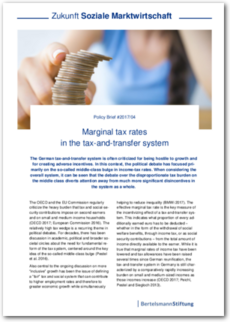The OECD and the EU Commission regularly criticize the heavy burden that tax and social-security contributions impose on second earners and on small and medium-income households in Germany. The relatively high tax wedge is a recurring theme in political debates. For decades, there has been discussion in academic, political and broader societal circles about the need for fundamental reform of the tax system, centered around the key idea of the so-called middle-class bulge. Also central to the ongoing discussion on more “inclusive” growth has been the issue of defining a “fair” tax and social system that can contribute to higher employment rates and therefore to greater economic growth while simultaneously helping to reduce inequality. The effective marginal tax rate is the key measure of the incentivizing effect of a tax-and-transfer system. This indicates what proportion of every additionally earned euro has to be deducted - whether in the form of the withdrawal of social welfare benefits, through income tax, or as social security contributions - from the total amount of income directly available to the earner. While it is true that marginal rates of income tax have been lowered and tax allowances have been raised several times since German reunification, the tax-and-transfer system in Germany is still characterized by a comparatively rapidly increasing burden on small and medium-sized incomes as those incomes increase.

Bertelsmann Stiftung (Hrsg.)
Andreas Peichl, Florian Buhlmann, Max Löffler, Manuela Barisic
Policy Brief #2017/4: Marginal tax rates in the tax-and-transfer system
- Ausgabeart
- Erscheinungstermin
- 17.08.2017
- Auflage
- 1. Auflage
- Umfang/Format
- 12 Seiten, PDF
Format
-
PDF
Preis
kostenlos


